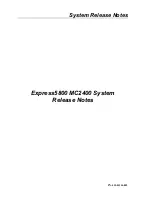
Configuring a multinode system
This topic provides information about configuring a multinode system.
You can configure a multinode server into a single logical server or partition it into two stand-alone partitions.
As a single logical server, the server is able to use resources from all scalable partitions.
Note:
When the server is configured as a single logical server, if there is an ac system power failure to one of
the nodes (partitions), the remaining good node powers itself down and remains off until the failing node
recovers from the ac power loss. After the power is restored, both nodes will automatically turn on and boot
as a two-node partition.
In a stand-alone server, each scalable partition supports an independent operating-system installation. In
addition, each scalable partition uses its own individual resources as an independent system. One stand-
alone server cannot boot an operating system on another stand-alone server.
The following is a list of the minimum components required to support the 8U x3950 X6 configuration:
• Four compute books (two in each node) with E7-8xxx microprocessors. The microprocessors must be of
the same cache size, type, and clock speed.
• The 8-socket chassis
• Two standard I/O books
• Two storage books
• A minimum of four power supplies (two power supplies in each node)
Before you create a multinode system, make sure that all the nodes in the multinode configuration contain
the following software and hardware:
• The current level of UEFI firmware and IMM firmware (all nodes must be at the same level)
• Microprocessors that are the same cache size, type, and clock speed
To check for the latest firmware levels and to download firmware updates, go to
Attention:
Installing the wrong firmware or device-driver update might cause the server to malfunction.
Before you install a firmware or device-driver update, read any readme and change history files that are
provided with the downloaded update. These files contain important information about the update and the
procedure for installing the update, including any special procedure for updating from an early firmware or
device-driver version to the latest version.
You can use the IMM2 web interface or the IMM2 telnet interface to manage scalable partitions.
You can use the Scalable Complex option under the Server Management tab on the IMM2 web user interface
for managing multinode systems. The Scalable Complex option enables you to partition nodes as separate
partitions or as independent nodes.
The following illustration shows the options under the Server Management tab on IMM2 web user interface
home page.
Configuration information and instructions
131
Summary of Contents for 6241
Page 1: ...System x3850 X6 and x3950 X6 Installation and Service Guide Machine Type 6241 ...
Page 6: ...iv System x3850 X6 and x3950 X6 Installation and Service Guide ...
Page 56: ...42 System x3850 X6 and x3950 X6 Installation and Service Guide ...
Page 82: ...68 System x3850 X6 and x3950 X6 Installation and Service Guide ...
Page 132: ...118 System x3850 X6 and x3950 X6 Installation and Service Guide ...
Page 158: ...144 System x3850 X6 and x3950 X6 Installation and Service Guide ...
Page 214: ...200 System x3850 X6 and x3950 X6 Installation and Service Guide ...
Page 358: ...344 System x3850 X6 and x3950 X6 Installation and Service Guide ...
Page 1938: ...1924 System x3850 X6 and x3950 X6 Installation and Service Guide ...
Page 1964: ...1950 System x3850 X6 and x3950 X6 Installation and Service Guide ...
Page 1968: ...1954 System x3850 X6 and x3950 X6 Installation and Service Guide ...
Page 1975: ...Taiwan Class A compliance statement Appendix F Notices 1961 ...
Page 1976: ...Taiwan BSMI RoHS declaration 1962 System x3850 X6 and x3950 X6 Installation and Service Guide ...
Page 1988: ...1974 System x3850 X6 and x3950 X6 Installation and Service Guide ...
Page 1989: ......
Page 1990: ......
















































